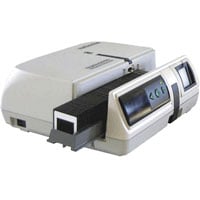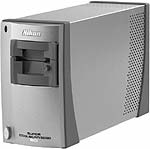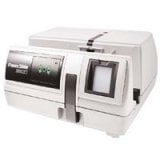How to Scan Your Slide Archive
This all-content, junk-free website's biggest source of support is when you use those or any of these links to approved sources when you get anything, regardless of the country in which you live. Buy only from the approved sources I use myself for the best prices, service, return policies and selection. Thanks for helping me help you! Ken.
March 2018 Better Pictures Canon Nikon Sony Fuji LEICA All Reviews
|
I buy only from these approved sources. I can't vouch for ads below. |
Do you really want to do this?
Time
This is a common question from people who haven't done it before.
First let's do some math: it takes at least five to ten minutes for each scan. Scanner makers lie: no scan you or I want really happens in 35 seconds. Even if it did, you still have to find and fumble with jamming each slide in the scanner and then waiting around while it scans, and then formatting and filing each scan as it comes off. At least on Apple's Mac OSX you can be working on the last scan in Photoshop while the next scan is scanning, but it still will take you 10 minutes a slide. Thus it will take you three months working 40 hours a week to do the scanning.
Three months later you'll probably change your opinion of what file format or resolution or color space or whatever you really wanted and have to start over.
Personally my time is too valuable to do this myself for large numbers of slides. I'd pay Chrome the 65 cents a scan just to do it for me. I've seen these scans and they're fine, although resolution is modest for making 4 x 6 prints. You can pay more for higher resolution.
If you insist on doing it yourself you have to get a scanner with a slide feeder so you can load it up and let it run itself all day and night. Few scanners have these available, and when they do the feeder is a rip-off. Unfortunately if you have 3,000 slides to scan you can't afford not to buy it, which is why they cost $500 just for the feeder which is pretty similar to a $60 stack loader for a Carousel projector. If you are a mad scientist you probably can spend $1,000 worth of your time building your own feeder, which will probably jam and destroy all your prized slides the first night you let it run on your own. Sorry, I've thought this all out and this is the way it goes.
These suggestions and prices are from back in about 2005~2007. Not many of these are still available new.
 Try the Braun Multimag Slidescan 4000 scanner, about $1,300 in March 2007.
Try the Braun Multimag Slidescan 4000 scanner, about $1,300 in March 2007.
 I'd get the Nikon
5000 scanner ($1,100) and the $500 slide feeder here.
An adapter for scanning long strips of uncut and unmounted film is here.
Remember that for 3,000 slides your main concern is speed and automation,
not price or image quality. Thank goodness the Nikon has ICE to get rid of the dirt automatically. You can worry about price and
image quality if you want to scan 30 slides, not 3,000.
I'd get the Nikon
5000 scanner ($1,100) and the $500 slide feeder here.
An adapter for scanning long strips of uncut and unmounted film is here.
Remember that for 3,000 slides your main concern is speed and automation,
not price or image quality. Thank goodness the Nikon has ICE to get rid of the dirt automatically. You can worry about price and
image quality if you want to scan 30 slides, not 3,000.
 Another cheaper idea which I have not tried personally is the new Pacific
Image PowerSlide 3600 for $800, complete. It comes with a 50-slide
feeder and is designed for scanning archives. I have not seen the scan
quality, however its rated at 3600 DPI. It lacks ICE,
which to me is a major flaw since you'll have to touch up all that dirt
manually later. The lack of ICE sort of
eliminates much of the benefit of the feeder. Then again, if it's a
choice between this scanner or no scans at all of your archive then
by all means order one and try it out. I'd get it here,
since you can return it if you hate it. Read the user comments at Amazon here,
you pay half of what the Nikon costs but you may have to deal with stuck
slides and software crashes depending on how lucky you are. Even with
that the people who own it seem to like it a lot.
Another cheaper idea which I have not tried personally is the new Pacific
Image PowerSlide 3600 for $800, complete. It comes with a 50-slide
feeder and is designed for scanning archives. I have not seen the scan
quality, however its rated at 3600 DPI. It lacks ICE,
which to me is a major flaw since you'll have to touch up all that dirt
manually later. The lack of ICE sort of
eliminates much of the benefit of the feeder. Then again, if it's a
choice between this scanner or no scans at all of your archive then
by all means order one and try it out. I'd get it here,
since you can return it if you hate it. Read the user comments at Amazon here,
you pay half of what the Nikon costs but you may have to deal with stuck
slides and software crashes depending on how lucky you are. Even with
that the people who own it seem to like it a lot.
So why did you want to do this anyway?
If it's to save space does the effort involved in scanning and storing and cataloging make up for it?
Never throw away your film. You always will want to go back to it with a better scanner 10 years from now if it's important.
If it's in anticipation of doing some digital editing of a few frames it's far easier to scan those frames when you need them.
If it's to distribute these photos to others you're still not done. You'll have to use an automated HTML maker like the one in Photoshop (MAC or PC) to reformat all the big scans into screen size images and galleries so that the normal people to whom you send your family archive can sort through the files. Also since you have to do this anyway you also can throw them up on a website for all to see, since those are the same files. For making a CD you need to get the .INI and .BAT files to put in the root directory of the CD so that they will just open automatically when a normal person pops it into their computer.
Data
Ask yourself just where and how are you going to store all of this data? How are you going to name all the files and folders so you can find everything so you don't have to go back and rescan it anyway, ha ha? Once you have it stored, how are you going to keep it backed up? The ability to backup is the best argument for doing all this scanning.
To store 3,000 35mm slides will take about 150GB as PSD or TIF files, which you can store and archive on one external hard drive. I'd suggest a hard drive; not DVDs or CDs. Why? Simple: it will take another lifetime to burn all the CDs or DVDs . Even worse, DVDs were never designed with the error correction levels of CDs and I've heard people who know warn against them for data archiving. We designed the DVD for MPG video where we can loose data; we realized the CD was overengineered for audio and wasted too much data on redundancy for error correction. We fixed that in the DVD making it less suitable for data files but better for releasing movie rentals.
Instead of TIF or PSD you can save nice JPGs instead and your archive would be about 15 GB. The advantage to this is you could store it all on a good laptop, too. Hint: if you are stuck for space you can save high resolution (3,200 DPI) files at a lower JPG quality setting and see far fewer artifacts than when you save for screen resolution. This is because the artifacts are confined to 8 x 8 pixel blocks which are much smaller and thus less obvious at higher resolutions.
© Ken Rockwell. All rights reserved. Tous droits réservés. Alle Rechte vorbehalten.
Help Me Help You
I support my growing family through this website, as crazy as it might seem.
The biggest help is when you use any of these links when you get anything. It costs you nothing, and is this site's, and thus my family's, biggest source of support. These places always have the best prices and service, which is why I've used them since before this website existed. I recommend them all personally.
If you find this page as helpful as a book you might have had to buy or a workshop you may have had to take, feel free to help me continue helping everyone.
If you've gotten your gear through one of my links or helped otherwise, you're family. It's great people like you who allow me to keep adding to this site full-time. Thanks!
If you haven't helped yet, please do, and consider helping me with a gift of $5.00.
As this page is copyrighted and formally registered, it is unlawful to make copies, especially in the form of printouts for personal use. If you wish to make a printout for personal use, you are granted one-time permission only if you PayPal me $5.00 per printout or part thereof. Thank you!
Thanks for reading!
Mr. & Mrs. Ken Rockwell, Ryan and Katie.




